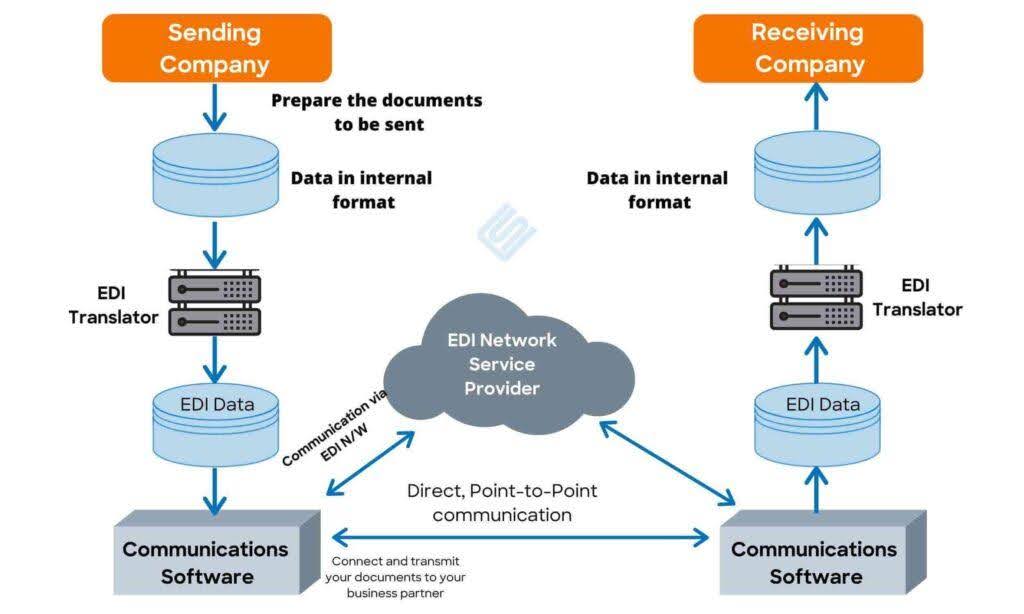The article is devoted to the principles of electronic document interchange (EDI) in the retail industry. The article describes the advantages of this approach in terms of increasing operational efficiency, reducing costs and ensuring security. The article considers the EDI system as an element of the global trend towards digitalization of the economy.
The author emphasizes that the approach can improve the efficiency of retailers of different sizes, from small chains to the largest marketplaces. At the same time, he warns that EDI implementation may be complicated due to resistance of company employees and financial reasons.
Traditional paper-based workflows and outdated digital systems slow down business development. They increase the likelihood of errors, slow down approval and decision-making processes, and complicate regulatory compliance.
For retail – from small retailers to marketplaces – where speed and accuracy of operations are critical, these factors directly impact competitiveness.
Digital transformation and electronic document interchange (EDI) enable companies to optimize processes, increase operational transparency, and create a flexible, data-driven business environment. These benefits are already being enjoyed by hundreds of companies in industries ranging from finance to medicine.
Retail is no exception. Large chains are already actively using EDI to optimize work with suppliers, manage inventory and increase employee productivity.
EDI is based on the digitalization of documents and automation of related processes. This approach saves companies from the need to use paper media, reduces the likelihood of data entry errors and speeds up the exchange of information between all participants in business processes.
The key principle of electronic document management is the structured exchange of data between companies’ information systems. Documents are transmitted in a standardized format that is understood by both parties, which eliminates the need for manual processing.
For example, it may look like this: the supplier receives an electronic order (ORDERS), the system automatically checks stock availability and generates an order response (ORDERS). The supplier then sends an electronic invoice (INVOIC) and the buyer receives a shipment notification (DESADV). This whole process takes minutes, whereas in the traditional format it could take several days.
EDI is not limited only to the transmission of orders and invoices. Retailers are actively using documents to approve price lists (PRICAT), confirm receipt of goods (RECADV), process returns (RETANN) and other operations. All these processes take place without human intervention if the systems are integrated and configured in accordance with the principles of electronic document management.
In addition to automating data exchange, electronic document management simplifies control and accounting. All information is stored in a digital archive, access to which is regulated by user roles and rights. This not only increases data security, but also helps businesses comply with legal requirements and exchange data with control and accounting systems. In Russia, these include, for example, EGAIS, Honest ZNAK or Mercury.
Thus, EDI implementation allows companies to optimize key business processes, reduce costs, speed up decision-making and increase the transparency of operations. This is especially important for retail, where the speed of document processing directly affects the efficiency of supply chains and the level of customer service.
Benefits of EDI in retail
Implementation of electronic document management provides retail chains and marketplaces with a number of significant advantages, allowing them to optimize processes and increase the efficiency of interaction with suppliers.
1) Increased operational efficiency. Document automation reduces order processing time, speeds up approvals and reduces the risk of errors.
For example, if the information system receives a notification that a certain product – butter, eggs or milk – has less than 100 kilograms left in stock, a purchase order is automatically created in EDI. The document is first sent to the main supplier, and if he fails to deliver the goods on time, it is automatically sent to the next counterparty. This process happens without human involvement, based on pre-configured logic.

Caption: the process of data exchange between companies can technically look like, for example, as in Illust.
2) Cost reduction. Paper documents require printing, storage, transportation and manual processing. By switching to EDI, these costs disappear and the speed of work increases significantly. The savings are especially noticeable for large retailers who manage hundreds of warehouses and purchase tens of thousands of different types of goods.
Let’s take an example: in the traditional approach, after selling goods from the warehouse, the supplier must bring the retailer several folders with closing accounting documents. Their analysis is a labor-intensive process: the accountant on the supplier’s side must manually analyze the entire array, find errors (on average, they are contained in 30% of the documents), form a statement of disagreement, return the paper documents to the supplier for revision, receive them after corrections and go through the entire process again. Once EDI is implemented, this process is automated and costs are significantly reduced.
3) Simplified interaction between departments and partners. Online access to documents allows employees from different departments, warehouses and stores to instantly exchange information. For example, a buyer can quickly coordinate changes in the price list with a supplier, and a logistician can check the delivery status without having to call or write to colleagues.
4) Security and compliance with regulatory requirements. All documents are encrypted, transmitted through secure channels and stored in accordance with legal requirements. The history of changes is recorded automatically – this simplifies auditing and allows for more effective control of processes.
5) Data-driven solutions. Integration with ERP and CRM systems allows analyzing sales, tracking inventory and forecasting demand. This helps retailers respond faster to market changes and optimize purchases.
Thus, electronic document management not only simplifies work with documents, but also becomes a strategic tool for retail, allowing companies to work faster, more efficiently and more transparently.
Challenges of EDI implementation in retail
Despite the obvious advantages of electronic document management, the process of its implementation is associated with a number of complexities that can slow down the digital transformation of a business.
One of the main problems is the inertia of large companies. Even if management realizes the benefits of automation, there can be resistance and reluctance within the company to change established processes.
For example, buyers are used to working in the old way – calling suppliers, discussing orders informally and manually entering data into the system. Going digital requires changing the usual working scenarios, which is often met with resistance from employees.
Another obstacle is the difficulty of restructuring business processes. EDI does not just replace paper documents with their digital counterparts, but also changes the very logic of interaction between companies. This requires careful elaboration of new work schemes, integration of EDI with existing IT systems (ERP, CRM, WMS) and testing at all stages of the supply chain.
In addition, EDI implementation requires investment. Before implementation, retailers and suppliers need to do a lot of work with the existing IT infrastructure – to compare product matrices, discuss and document document document formats, data exchange formats, document processing regulations. After that, they need to conduct test exchanges, get feedback, correct all errors – and only then can they officially switch to EDI.For large retailers with thousands of stores and hundreds of suppliers, this process can take considerable time.
The steps described above require dozens of hours of work by expensive specialists on both the retailer’s and the supplier’s side. However, the relatively high investment in the project is guaranteed to pay off.
Technical complexities also play a role. Different vendors may use different data formats and workflow systems, which requires customization of data conversion and unification of processes. Without a common standard, collaboration between companies can become more complex.
Despite these challenges, companies that have successfully implemented EDI report significant efficiency gains and cost reductions. The main thing is a thoughtful approach to implementation, support for changes at all levels of the company and a phased transition to a digital format.
Conclusion
Digital transformation of retail is no longer a trend, but a must for businesses that want to remain competitive. Electronic document management is becoming a key tool of this transformation, helping to automate processes, reduce costs and increase the transparency of operations.
The development of artificial intelligence and machine learning technologies will make it possible to automate even more routine processes, from order analysis to demand forecasting. It is likely that in the future, algorithms will be able to independently determine optimal procurement volumes, suggest alternative suppliers and even negotiate contract terms without human involvement.
Another important trend is the in-depth integration of EDI with other digital systems. Even today, document management platforms work in conjunction with ERP, CRM and WMS systems, but in the future their interaction will become even closer. This will allow companies to track the movement of goods in real time, react instantly to changes in demand and quickly reorganize logistics.
In addition, electronic document management will become an integral part of sustainable business development. Refusing paper documents not only reduces costs, but also reduces a company’s impact on the environment. This factor is becoming more and more important in the context of growing requirements for the environmental responsibility of brands.
Literature
1) Applications of electronic data interchange technology in retail business: advantages and barriers to implementation, 2010
https://jbrmr.com/cdn/article_file/i-5_c-36.pdf
2) A Case Study of Internet EDI in the Retailing Supply Chain A Case Study of Internet EDI in the Retailing Supply Chain, 2011
3) What is EDI (Electronic Data Interchange)?
https://aws.amazon.com/what-is/electronic-data-interchange/?nc1=h_ls
4) Electronic Document Management System as an Element of Enterprise Digitalization, Scientific Aspect, 2023
5) Role of Electronic Data Interchange ( EDI ) in Improving The Efficiency of Accounting Transactions-Palarch’s, 2020



































